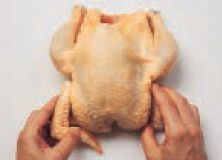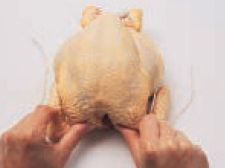Advertisement
Trussing Methods
Appears in
Published 2014
Trussing means tying the legs and wings against the body to make a compact, solid unit. It has two main purposes:
- Even cooking. Extended legs and wings cook too quickly.
- More attractive appearance, especially when presented or served whole or carved in the dining room.
One of many trussing methods is illustrated in Figure 17.3. Your instructor may wish to show you other methods.
Figure 17.3 Trussing chicken.
- Place the chicken breast up, with the neck end toward you. Tuck the first joint of the wings behind the back.
- Press the legs forward and down against the body.
- Pass the center of a length of twine under the hip bone just ahead of the tail.
- Bring the twine up and across the ends of the legs.
- Pass the twine under the ends of the legs as shown and pull tight.
- Bring the ends of the twine toward the neck end of the bird. Pull firmly on the twine while pressing on the breast portion with the thumbs as shown.
- Tie the twine tightly.
- The stub of the neck holds the twine in place, preventing it from slipping behind the back.
- The trussed chicken.










